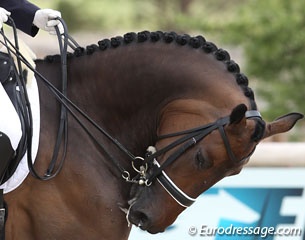
Guest columnist of the week is long-time Eurodressage contributor Silke Rottermann, who is renowned for her detailed history articles on the Greatest Oldies in dressage as well as in depth articles on classical dressage training. Rottermann shares her view on the recent banning by law of rollkur in Switzerland.
Switzerland Legally Bans Rollkur, Hip Hip Hoorah?
A large group of members of the online equestrian community are celebrating the brand new Swiss law banning rollkur. Switzerland may be a small country outside the European Union, but it is well-known within Europe for its often strict and pioneering animal welfare acts.Valid as of 1 January 2014 "methods with which the overbending of the horse's neck or back is induced are restricted" by Swiss law. In other words, Switzerland is the first country in the world, which has now banned the so-called rollkur by national law.
Sounds great at first look, but I must confess that I don't join the „hip-hip-hooray“-mood many are spreading on the net. Also in this case the old question is raised: will this new animal welfare law be paper which doesn't blush or are there exact definitions given of which behaviour or riding style a rider can be judged and punished?
The Swiss Federal Agency for Veterinarian Affairs explains that „the rollkur, also called hyperflexion, is a particularly deep head-neck-position of the horse. The back is over-bent during it. This attitude in dressage riding is forced through violent action of a rider's hand or through tools. Relevant for animal welfare and thus forbidden are extreme cases in which the unnatural attitude of the horse is apparent and in which the hyperflexions last over a few minutes.“
The first major issue that comes to mind is that by referring to "dressage riding" does it exclude show jumpers or reiners, who are repeat offenders as well? Secondly, rollkur/hyperflexion is at least vaguely defined in this text. What are extreme cases of rollkur / hyperflexion and how many minutes are a „few minutes“? The answers seem up to individual interpretation. There is a vague, grey zone between rollkur/ hyperflexion and LDR. According to FEI rules -- to which Swiss law refers -- the rollkur/hyperflexion-position is a flexion obtained with force, thus differing from LDR which is acceptable up to ten minutes in a warm-up.
Apart from the problem concerning exact terminology, another major concern is how Swiss law will be implemented in practice. As this is not a rule of the Swiss Equestrian Federation but in fact a national law, it is first and foremost the assignment of the police to investigate if and how law is broken.
How can we visualize Swiss dressage shows in the future then? A policeman at the warm-up or at least occasional patrols on the show grounds? Police officers trained to detect an extreme case of rollkur? I might be exaggerating, but it seems as hard to control the compliance of this new law as it is to control whether cows are being kept in exercise pens on a farm.
Will the mode of practise be stewards reporting to the local police by providing mobile phone footage as a proof? Or can the visitors and show spectators become actual vigilantes as many of them feel competent enough to judge on something which is not clearly defined? Don't get me wrong, I am not aiming to ridicule this serious topic. I don't want to do injustice to the best intentions the law surely has. They deserve to be honoured and also the fact that its applicability causes another debate on a very important topic and animates animal welfare societies to demand a ban in their own country is laudable.
As praiseworthy the intentions of Swiss policy might be, to me it rather seems a half done thing and thereby difficult to put a paper law into effective practice. What is needed most, apart from exact terms of reference, is civil courage from the FEI stewards who supervise the warm up. Legal inaccuracies leave much leeway for interpretation. They will inhibit civil courage and probably lead to nothing.
by Silke Rottermann